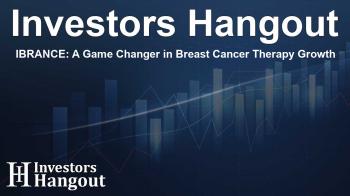IBRANCE: A Game Changer in Breast Cancer Therapy Growth

IBRANCE: Leading the Charge in Breast Cancer Treatment
Since its introduction, IBRANCE (palbociclib), developed by Pfizer, has transformed the treatment landscape for metastatic HR+/HER2- breast cancer. Launched in 2015, the drug has already been prescribed to over 200,000 patients across the globe. This significant adoption underscores its efficacy and the crucial role it plays in patient treatment plans. IBRANCE is an oral medication that inhibits cyclin-dependent kinases 4 and 6, essential regulators in the cell cycle, impacting how cancer cells proliferate.
Understanding IBRANCE and Its Market Potential
IBRANCE is recognized for its effectiveness in combination with aromatase inhibitors among postmenopausal women and men with advanced cases of HR+/HER2- breast cancer. The ongoing success of IBRANCE can be attributed to its provision of a robust option where traditional therapies may fall short, particularly for patients whose diseases have progressed after endocrine therapies.
The Competitive Landscape: IBRANCE Against Its Rivals
In the current market, IBRANCE faces competition from other significant players in the CDK4/6 inhibitor space, which includes drugs like Novartis' KISQALI and Eli Lilly's VERZENIO. Despite this, IBRANCE remains highly regarded due to extensive clinical research and positive trial outcomes that confirm its efficacy. Data indicate that combination therapies, as seen with IBRANCE, generally yield better response rates compared to single-agent endocrine therapies, a clear advantage as cancer treatment protocols evolve.
Current Treatment Trends in HR+/HER2- Breast Cancer
The HR+ HER2- breast cancer subtype is the most prevalent globally, and the treatment landscape has significantly evolved. The introduction of targeted therapies, particularly CDK4/6 inhibitors, mTOR inhibitors, and PARP inhibitors, has broadened the treatment arsenal available to oncologists. These advancements are not only improving survival rates but also enhancing the quality of life for patients experiencing the rigors of cancer treatment.
Emerging Therapies on the Horizon
As the field of cancer therapy progresses, new innovations are on the cusp of approval and introduction to the market. Notable emerging competitors to IBRANCE include Gedatolisib and ARV-471, along with ongoing studies exploring the efficacy of innovative combinations that may further enhance treatment outcomes. For instance, research presented at major oncology symposiums showcases the potency of these combinations in treating advanced forms of HR+/HER2- breast cancer.
Key Milestones and Regulatory Approvals
IBRANCE has experienced several landmark regulatory approvals, enhancing its therapeutic reach. Notably, the drug received a U.S. Patent Term Extension, extending its protection significantly, which allows Pfizer to safeguard its investment in this important therapeutic area. These milestones reflect the drug’s continued evolution and adaptability in a rapidly changing healthcare environment.
Market Dynamics Influencing IBRANCE's Growth
The market dynamics for IBRANCE are primarily shaped by the demand for precision medicine and the increasing emphasis on personalized cancer care. Healthcare providers are gravitating toward therapies that offer targeted solutions, which is where IBRANCE's profile shines. However, potential challenges include navigating competition and the evolving landscape of drug pricing and insurance approvals. Increased scrutiny on the cost-effectiveness of cancer treatments may impact the accessibility of IBRANCE, particularly in regions with limited healthcare funding.
Global Reach and Future Outlook
IBRANCE's market is expected to expand significantly, propelled by the rising incidence of breast cancer diagnoses and advancements in treatment technologies. While its primary market lies in North America and Europe, Pfizer aims to address growth in emerging markets where access poses a challenge. Partnerships and strategic pricing adjustments are pivotal for broadening IBRANCE’s footprint internationally.
Frequently Asked Questions
What is IBRANCE?
IBRANCE is an FDA-approved drug that inhibits certain proteins essential for cancer cell division, specifically used to treat advanced HR+/HER2- breast cancer.
How does IBRANCE work?
It works as a CDK4/6 inhibitor, disrupting the cancer cell cycle, thereby preventing the growth and spread of cancer cells.
Who can use IBRANCE?
It is prescribed to adult patients with HR+/HER2- advanced or metastatic breast cancer, often in combination with other treatments.
How has IBRANCE impacted market dynamics?
IBRANCE has established a strong foothold in the treatment of breast cancer, influencing both clinical practices and patient outcomes significantly.
What are the emerging competitors in the market?
Emerging drugs such as Gedatolisib and ARV-471 pose competition to IBRANCE, pushing innovation in treatment options for breast cancer.
About The Author
Contact Lucas Young privately here. Or send an email with ATTN: Lucas Young as the subject to contact@investorshangout.com.
About Investors Hangout
Investors Hangout is a leading online stock forum for financial discussion and learning, offering a wide range of free tools and resources. It draws in traders of all levels, who exchange market knowledge, investigate trading tactics, and keep an eye on industry developments in real time. Featuring financial articles, stock message boards, quotes, charts, company profiles, and live news updates. Through cooperative learning and a wealth of informational resources, it helps users from novices creating their first portfolios to experts honing their techniques. Join Investors Hangout today: https://investorshangout.com/
The content of this article is based on factual, publicly available information and does not represent legal, financial, or investment advice. Investors Hangout does not offer financial advice, and the author is not a licensed financial advisor. Consult a qualified advisor before making any financial or investment decisions based on this article. This article should not be considered advice to purchase, sell, or hold any securities or other investments. If any of the material provided here is inaccurate, please contact us for corrections.

